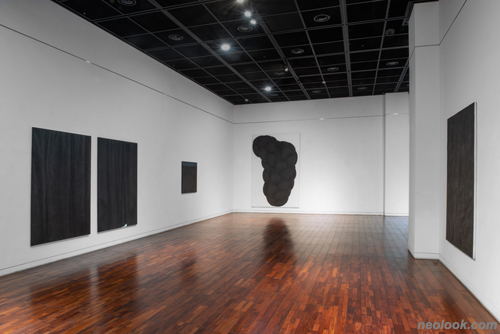- ● homepage
- ● archives
- ● restoration
- ● books
- ● big banners
- ● post board
- ■ neo's search
- ■ about us
- ■ 게재방법 안내
- 개인정보처리방침

- [email protected]
- Tel. 02_335_7922
- Fax. 02_335_7929
- 10:00am~04:30pm
- 월요일~금요일
- 3/3(월) 대체공휴일

다른 곳으로 Autre part
유혜숙展 / YOOHYESOOK / 柳惠淑 / painting 2020_1030 ▶ 2021_0123 / 월,화요일 휴관
● 위 이미지를 클릭하면 네오룩 아카이브 Vol.20200616b | 유혜숙展으로 갑니다.
별도의 초대일시가 없습니다.
관람시간 / 10:30am~05:00pm / 월,화요일 휴관
우종미술관 UJONG MUSEUM OF ART 전라남도 보성군 조성면 조성3길 338 Tel. +82.61.804.1092 www.ujongart.com
고요한 긴장 ● ...1990년대 초기에 제작된 작품들은 채색된 평면들의 중첩과 병치를 이루는데, 이는 그 구성과 색조 양자의 측면에서 마크 로스코(1903-1970)의 작품들을 환기시킨다. 하지만 이들 작업들은 이 한국작가에게 있어서 오래 지속되지 않은 것으로 보인다. 왜냐하면 평면에 활력을 불어넣는 절제된 작업이 자아내는 단순한 평면과 구성에 대해 그녀는 그다지 관심이 없었던 것으로 보였기 때문이다. 하지만 다른 한편으로 1991년 시작된 일상생활 요소들의 재현에 관한 시리즈들은 지속적인 발전의 사슬에서 첫 번째 고리인 것처럼 보인다. 이는 1990년대부터 오늘날까지 이 예술가의 여정을 형성하고 있다. 또한 유혜숙은 드로잉과 회화, 구상과 추상 사이의 중간지대에 대한 탐구를 시도한다. 그녀는 다양한 방식으로 일상생활의 요소들을 기술한다. 예를 들면 하얀 바탕 위에 고립되어 놓인 해부학적 자양물 혹은 덩어리들이 그것들이다. 이 주제는 이 작가로 하여금 동시에 여러 다른 스타일 예를 들면, 세부적 드로잉으로부터 어떤 실루엣을 환기시키는 단순한 얼룩에 이르기까지 실험해 보게 한다. 더 나아가서 이러한 재현들이 실제 대상물의 동일화 과정을 풍성하게 하는 내용으로 연결될 수 있는 방식을 탐구하게 하고 있다. 동일한 주제를 다루는 연속적인 작품들은 묘사된 대상의 전개 혹은 레이아웃의 변화에 기반을 둔 여러 원초적 나레이티브 도식들을 설정하게 하고 있다. ● 이러한 작업은 '대상읽기'(Lire les objets)라는 제목의 시리즈 속에서 추구되고 있다. 이 제목은 드로잉의 방식으로 그녀에게 놓인 환경 탐구에 대한 이 작가의 의지 뿐만 아니라 종이 위에 탐구되고 이식되는 것에 대해 단순한 형식적 유희를 넘어서서 어떤 의미를 부여하려는 작가의 역량을 명백하게 환기시키고 있다. 이러한 일련의 작업들은 본질적으로 땅콩 혹은 붉은 강낭콩의 재현에 관한 이전에 시도된 그리고 이후에도 중심이 되었던 탐구의 추구로 이루어진다. 이를 위한 주된 방안은 기념비적 포맷을 선택하는 것이었다. 이는 대상에 대한 대중의 '읽기'를 활성화하고, 작가로 하여금 어떤 설득력 있는 방식에서 단계의 변화를 수행하도록 대상들의 분석과 해체의 섬세한 과정을 필요로 하게하고 있다. 이러한 단계의 변화는 이전에 시도된 여러 조형적 과정에 기반을 두고 있다. 즉 관찰된 주제의 질감과 사건의 세부를 재현하거나 이들 대상을 다소 미묘한 점과 면에 의해 형성된 단순한 실루엣으로 변형하는 것이다. ● 땅콩 형태는 유혜숙 작업 특유의 진화 메커니즘에 따라 2000년에 '머리결'로 돌연변이를 하게 된다. 이러한 변모는 이 작가의 작업이 이론적이고 미학적인 단절을 보여주기 보다는 형식적 지속성과 테크닉을 선호하는 경향으로 나타난다. 머리칼 웅큼은 검정 아크릴릭으로 채색될 수 있지만, 이 작가의 머리결은 흑연을 사용한 인내력이 수반된 드로잉작업이다. 이 작업에서는 일부 땅콩작품에서처럼 그의 양감과 질감이 회복되고 있다. 이 머리결 소재는 마치 그 머리결의 임자로부터 분리된 것처럼 흰 배경 위에 외따로 떨어졌기 때문에 특히 충격적인데, 다른 양상으로도 표현된다. 즉 뒷모습의 여성 두상의 인상적인 재현에서부터 클로즈업 되어 보여지는 머리 가르마의 묘사에 이르기까지 여러 범위로 표현된다. 작가로 하여금 핵심적인 원초적 인식을 부여하는 이 작업 시리즈는 심리학, 문화연구 그리고 성 연구에서 많은 해석을 야기하여 왔다. 머릿결의 소재는 그러므로 종종 한국적 여성성의 분명한 암시로 이해되어진다. 특히나 묘사된 헤어스타일 유형을 보면 이는 더욱 그러하다.

- 유혜숙_다른 곳으로展_우종미술관_2020
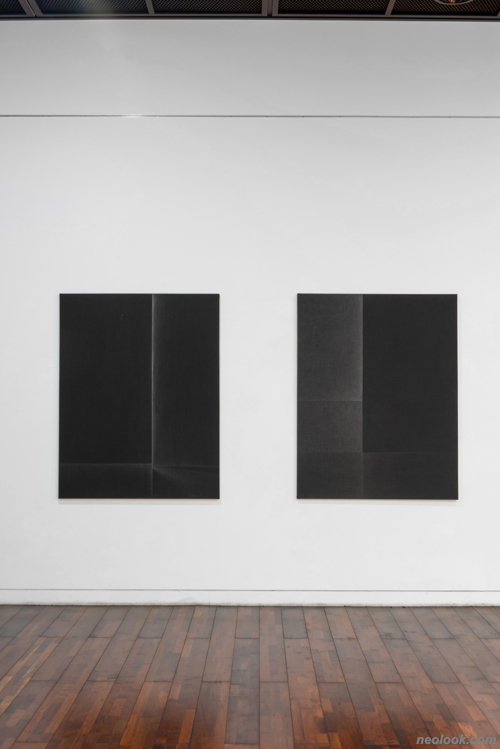
- 유혜숙_다른 곳으로展_우종미술관_2020
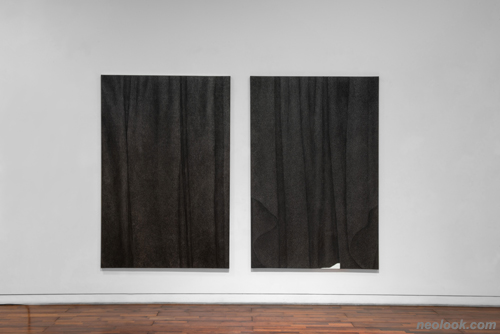
- 유혜숙_다른 곳으로展_우종미술관_2020
이 작가는 머리칼과 체모 사이의 등가성을 강조함으로써 그러한 주제로부터 떠오르는 동물성을 두드러지게 한다. 이러한 작업은 이 작가를 고무시켜서, 2005년부터 지속적으로 머리결의 소재를 이따금씩 털의 재현을 위한 것으로 다루게 한다. 여러 작업에서 이러한 주제의 다양한 변화는 이전에 보여주었던 변화만큼 프레임의 다양함을 보여준다. 그러므로 어떤 작업들은 털이나 의류 조각들이 하얀 배경 위에 외따로 떨어져서 머리털로 존재하게 되는 반면에, 또다른 어떤 작업들은 추상적으로 표현한 머리결의 방식으로 동물의 털에 의해 완전히 덮혀진 화면을 보여주게 된다. 2011년부터 유혜숙은 이 이미 검증된 프로세스에 이러한 주제로 충만한 필드를 확장하고자 한다. 2013년까지 지속된 일련의 시리즈는 풍경의 차원을 캔버스에 도입한다. 상단부는 파랗게 칠해져, 하늘로 보이게 하고 그 밑부분에 털의 주름에 의해 형상화된 산악이 전개된다. 2015년에는 거의 10년간 이용되어 왔던 일종의 도상학을 갱신하기 위해서 이러한 탐구의 마지막 아바타가 등장하는데, 이는 가죽천으로 테이블 위의 기하학적 물체를 덮는 것이다. ● 하지만 이 주제는 점차적으로 퇴색하게 되는데, 말하자면 아카데믹하게 묘사된 주름 연출로 관객의 관심집중이 빛의 처리로 향하게 되므로서 결국 그 의미가 공허해지게 되기 때문이었다. 결국 유혜숙은 이 주제를 포기하게 된다. 브레타뇨 지방의 케르게넥(Kerguéhennec) 에서의 레지던시 기간 동안인 2016년에 제작된 물의 도면(plan d'eau) 시리즈 작품들은 이러한 과도기에서 주요한 역할을 한다. 물표면의 클로즈업된 모습의 재현은 여러 잔물결의 반향으로 비춰지게 되는데, 빛의 효과를 포착하려는 작업으로 계속된다. 이로서 이전의 작업흐름들은 점점 축소되게 된다. 하지만, 이는 이 작가로 하여금 선에 의한 드로잉의 세밀함을 버리게 하고, 빛의 파열을 재현하기 위해 평면을 더 선호하게 한다. 이러한 작업은 간단히 말해서 새로운 유형의 작업을 탄생시킨 2015년의 강한 수평선으로 점철된 작품들의 엄격함과 결합한다. 검은 배경은 그대로이지만, 테이블은 침대가 된다. 침대의 시트는 케르게넥 레지던시에서 실험된 과정에 따라 처리되었다. 이와 같은 보다 큰 영역에서 빛의 처리는 에드워드 호퍼(1882-1967)의 회화적 전거들, 즉 창문을 마주하는 침대와 맥을 같이 한다. 그렇지만 유혜숙은 작품에서 인격성을 배제하고, 멜랑콜리로 바꾸어 놓는다. 따라서 이들 작품들은 낯설은 불안함의 감정 전달자이게 된다. 이 낮선 불안의 감정은 오랫동안 인테리어 시리즈에서 지속된다. 이 시리즈는 점차적으로 모든 대상이 제거되어서 결국 반그림자의 흔적에 의해 형성된 고요한 공간으로 귀결되며, 이는 오늘날까지 주된 주제가 되어 왔다.
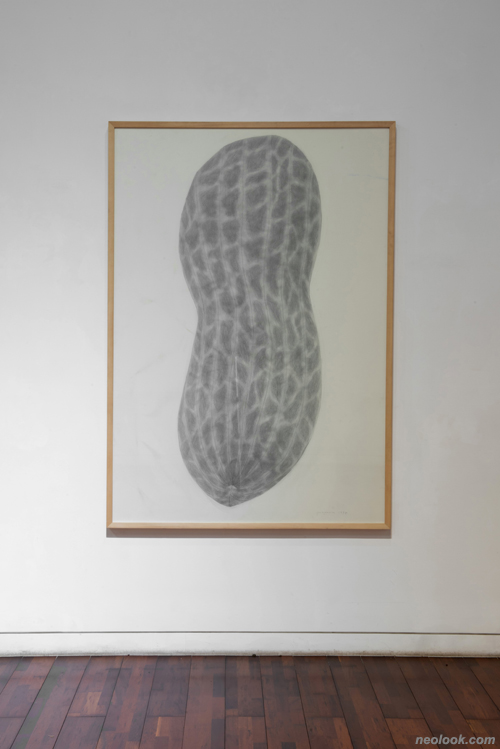
- 유혜숙_Untitled(cacahuète)_종이에 연필_174×121cm_1997
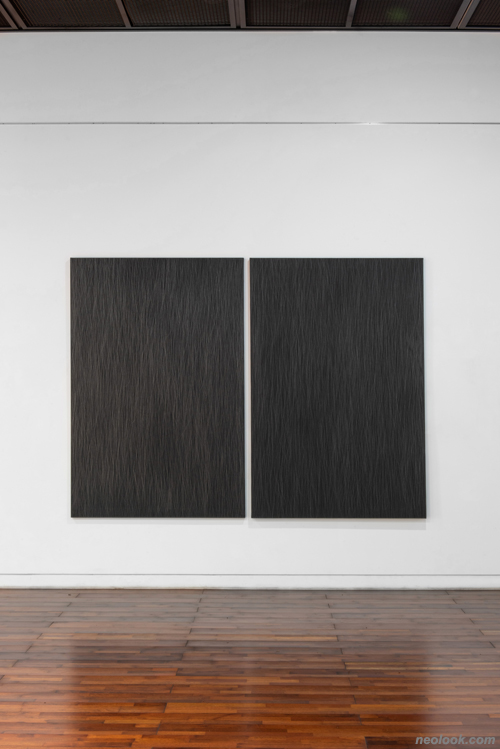
- 유혜숙_Untitled_캔버스에 아크릴채색, 흑연_각 193.9×130.3cm_2020
이와 같이 선의 상대적 진화는 1990년대의 '자양물' 재현으로부터 오늘날 이 작가의 주된 작업인 비어있는 건축물로 이어지는데, 이는 한 시리즈로부터 또 다른 시리즈로의 형식과 표현의 전환 메커니즘에 기반을 두고 있다. 그러므로 각각의 단계는 일련의 시각적, 기술적 혹은 의미론적 등가성에 의해 이전의 단계와 연결되는 것이며, 또 다른 단계로 이어지는 것이다. 이러한 타임라인에서 단지 두 개의 작업유형만이 예외인 것으로 나타난다. 그 하나는 에샤르드(Échardes) 시리즈로서 2003년에서 2010년 사이에 제작된 일련의 드로잉과 릴리프이며, 또 다른 하나는 2009년에서 2014년 사이에 진행되었던 '별자리'(Constellations) 시리즈이다. 머리결을 주제로 한 설치실험과 간헐적인 사진작업의 시도는 별개로 하고 상기한 작업들의 주제와 기술적인 면에서의 독창성은 이들 작업에 특별한 지위를 부여할 수 있다. 그 중에서도 일관성이 유지된 작업들은 더욱 그러하다. 이러한 기발함은 유혜숙 작품의 어떤 국면들을 비춰주고 있는데, 그것은 통상적으로 어떤 테크닉의 연속체에 그러한 기발함의 깃듦에 의해 부분적으로 모호하게 하는 것이다. ● 사실상 머리칼과 털에서 이 작가에 의해 느껴지는 동물성, 야만성은 길고 섬세한 테크닉의 채택에 의해 통제되는 반면에 에샤르드(Échardes) 시리즈는 공공연한 공격성을 표출하고 있다. 릴리프에서처럼 드로잉에서도, 핑크색의 띠들은 다수의 봉우리로 이루어진 그의 외적 표면 위에 곤두서있다. 이들 드로잉에 불규칙적인 윤곽들과 이들 띠들의 뒤엉킴은 내부의 가시로 연결되는데, 이는 의자라는 사실을 잊게 하는 것이기도 하다. 반은 초현실주의적이며, 내적 감정의 외적 폭력으로부터 그리고 상징화된 표현으로부터 자아낼 수 모든 것 내에서 그러한 주제의 선택은 예상하지 못했던 불안정성을 중심으로 유혜숙 작업의 통합을 고취시키고 있다. 이 작가의 주제와 테크닉을 통해, 이 작가의 작업은 특히 드로잉을 개인적 표현의 탁월한 방식으로 실천하는 여성작가들 그중에서도 많은 한국 여성작가들의 작업과 근접시킬 수 있다. 이러한 견지에서 유혜숙의 전반적인 작업은 작가의 의도, 즉 구체적 대상 혹은 공간으로부터 관객을 명시적인 비인칭적 처리로 마주 대하려는 작가의 의도에도 불구하고, 자기 성찰적이 되고 있다.
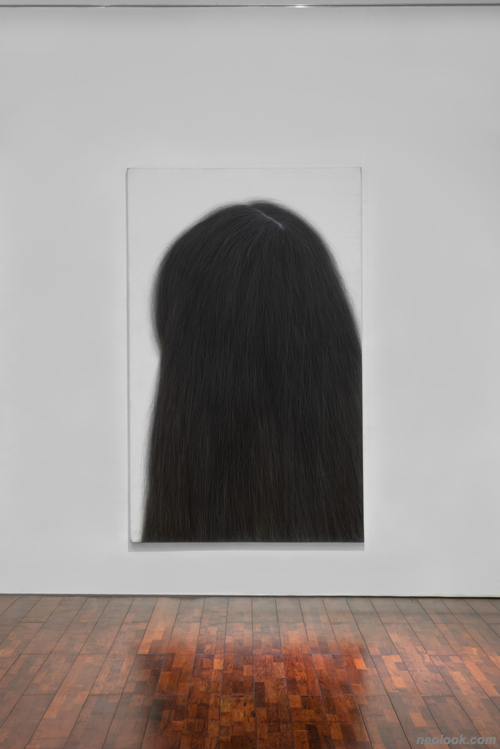
- 유혜숙_Untitled(cheveux)_캔버스에 아크릴채색, 흑연_250×145cm_2003
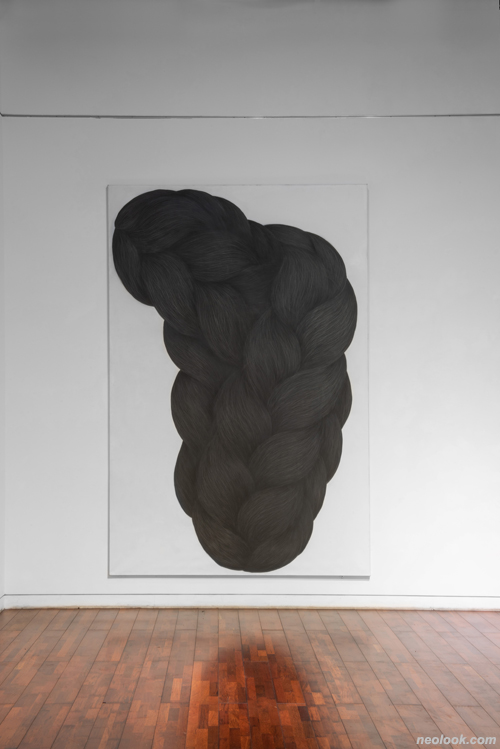
- 유혜숙_Untitled(cheveux)_캔버스에 아크릴채색, 흑연_300×200cm_2003
별자리(Les Constellations) 시리즈는 이러한 공격성을 또 다른 방식에서 표현하고 있는데, 여기에서는 테크닉에 의거하고 있다. 바닥에 깔린 검은 종이 위에, 유혜숙은 육체적으로 자신의 팔다리가 굳어지는 것을 느끼며, 격렬하게 연필을 휘두르는데, 종이 위에 그려지는 점과 선은 그녀의 몸을 지지하게 된다. 이따금 흑연으로 구멍을 내면서 이 작가가 재료의 물리적 한계를 시험하는 방식, 그리고 이 작가가 자신의 몸짓 흔적들을 새겨나가는 방식은 분명 한국에서 단색화 열기 이래로 한국미술현장의 작가들에 의해 두루두루 공유되는 경향을 띤다. 하지만 이 과정에서의 보이는 야만성(brutalité)은 유혜숙 작가에게 고유한 것이다. 사람들이 이러한 야만성이 정신적 필연성에 반응하지 못한다고 생각하지 않는다면, 야만성은 어떤 조형적 역할을 상정하게 하는 듯 싶다. 그리고 이 야만성은 이 작가로 하여금 2000년대 초기 이래 보여주었던 주제와 섬세한 장인정신을 결국 포기하게 하였다. 그러한 장인정신은 '물의 도면'(des plans d'eau) 시리즈 흐름 이전에 그리고 선에 의한 드로잉연습을 포기하기 이전에는 거의 중단되지 않았던 것이다. ● 십여 년간 어떤 주제에서 보여주는 동물적 속성과 같이 공격적 형태의 표현방법은 유혜숙의 작품 전체를 다시 생각해 보게 되며, 거기에는 난폭한 충동의 맥락과 느리고 제한적인 작업 방식으로 그 충동들을 길들이고 테크닉으로 통제하는 그 사이에서의 긴장감이 규칙적으로 보여진다 최근의 진화된 작업들은 이러한 해석을 보다 공고히 할 수 있는 듯이 보인다. 2016년과 2018년 사이에 작업된 '내부'(les intérieurs) 시리즈는 위압적인 존재감을 유지하는 틀-바깥(hors-champs)의 구성으로 특정 지워진다. 여기에서 문입구 혹은 외길복도는 아무것도 분간하지 못하게 하는 어둠 속으로 진행하는 듯이 보인다. 하지만 거의 2년 동안, 클로즈업의 사용은 관객의 시야를 어떤 빛에 초점을 맞추게 한다. 이 빛은 천천히 흐릿한 빛 속으로 표류하게 한다. 광원의 모호함은 이전의 공간 작업에서와 동일한 방식으로 불안감을 야기하기도 하지만, 안정적이기도 하다. 작가는 이러한 안정감을 그가 최근에 발견했다는 더 큰 고요함으로 연결해 나가고자 할 수도 있을 것이다. 유혜숙은, 개인적 일화에 동의 않으면서도 자신의 내면을 성찰함과, 하이퍼리얼리즘과 숭고한 추상, 회화와 드로잉이 서로 혼합되어 자신만의 어휘를 창조하게 한 긴 여정의 끝에 평정을 찾게 될 지도 모른다. 하지만 이 작가가 자기만의 규율을 갖는 창작성을 배제하지는 않을 것이다. 결국 그녀의 작업을 특징짓는, 일종의 전매특허와도 같은 '차분한 긴장감'을 자아내는 것은 바로 이것이기 때문이다. (도록 평론글 발췌) ■ 마엘 벨렉
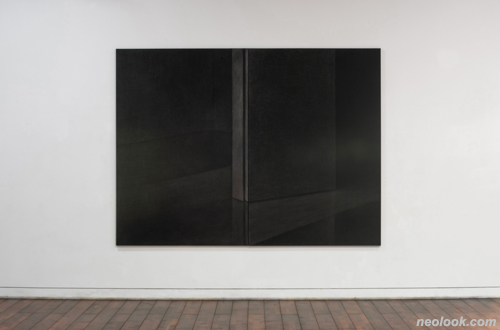
- 유혜숙_Untitled_캔버스에 아크릴채색, 흑연_193.9×260.6cm_2017

- 유혜숙_Untitled_캔버스에 아크릴채색, 흑연_193.9×390.9cm_2020
Calm tensions ● …Paintings realized at the beginning of the 1990s consist indeed in the superposition and juxtaposition of colored plans, which remind those of Mark Rothko (1903-1970), both through their compositions and their chromatic range. This production appears short lived nonetheless for the Korean artist, although she already reveals her attraction to flat tints and simple compositions, dynamized by a discrete work at animating surfaces. However, the series initiated in parallel in 1991, on the representation of elements of everyday life, appears like the first link of a chain of successive evolutions, which will determine the artist's journey from the 1990s to this day. Yoo Hye-Sook then initiates a search placing her mid-way between drawing and painting, between figuration and abstraction. She describes elements of everyday life in a variety of ways, food or anatomic pieces on a white background. This subject allows her to play different styles, from a detailed drawing to a simple spot which evokes a silhouette, but also to explore the way in which these representations can connect to a content which enriches the identification process of the real point of contact. The succession of sheets treating the same subject allows her in particular to implement rudimentary narrative patterns based on the evolution of figured objects or variations of compositions. ● This work is pursued in a series called "reading the objects", title that explicitly reminds the artist's desire of exploring her environment with drawings, but also her capacity to give some meaning to what is scrutinized and transposed on paper, further than a formal play. This assembly of works essentially constitutes in the pursuit of research previously initiated, and now centered on the representation of peanuts or red beans. The major innovation resides in the choice of a monumental format which facilitates the interpretation of objects by the public and makes necessary for the artist a meticulous analysis and deconstruction process of the latter in order to convincingly operate the change of scale. This change relies on multiple plastic processes previously experimented, whether by reproducing the detail of textures and accidents of the observed subjects, or shed them into a simple silhouette, obtained with spots or flat tints more or less nuanced. ● The peanut's shape allows the mutation of this pattern into a braid of hair, in the year 2000, following a mechanism characteristic of Yoo Hye-Sook's work, more inclined to privilege formal and technical continuities than to conceptualize theoretical and aesthetical interruptions. If the heap of hair is painted with black acrylic, it is a patient work of graphite drawing which, like certain peanuts, restitutes its volume and texture. The hair pattern, particularly stunning because isolated on the white background, like detached from any human owner, is also declined following other forms that extend from the impressive representation of feminine heads from the back, to the description of the hair partings in a close up. This series, which allows the artist to gain a first critical acknowledgement, gave rise to numerous interpretations: psychological, cultural or gender studies. The hair's pattern is also regularly understood like an obvious allusion to Korean womanliness, especially because the of types of hair represented. ● The artist, on her side, insists on the equivalence between hair and pilosity, in order to underline the animality that emerges from such a topic. Starting in 2006, this leads her to opt for a representation of fur, while continuing to occasionally treat the motive of hair. The multiple variations of this theme in various arrangements witness the same evolutions in the framing as previously observed. In this way, while pieces of fur or clothing are isolated on a white background, like the hair braids, other canvasses favor a surface totally covered by fur, in the way of the hair partings, grazing abstraction. Yoo Hye-Sook adds to these proven processes the will to extend, as of 2011, the field covered by this topic. A series continued until 2013 introduces a scenic dimension in her paintings, the top of them painted in blue acting as a sky under which orographies materialized by pleats of fur spread out. In 2015, the last avatar of this research destined to renew an iconography used for over ten years sees skins layered on geometrical volumes on a table. ● The progressive dissolution of the subject, devoid of its meaning by the focalization of the audience's attention on the treatment of light, at the expense of a quasi-academic staging of the fabric folds, allows Yoo Hye-Sook to abandon the theme. The series of lakes realized in 2016 in a residence in the Domaine de Kerguéhennec, in Brittany (France), plays a major role in this transition. The representation of an assembled vision of aquatic surfaces, illuminated by a few glares on ripples, pursues the work of capturing the light effects to which were reduced more and more he previous works. It nonetheless allows the artist to abandon the meticulousness of line by line drawing, in aid of flat tints destined to represent the radiance of light. The treatment of this light with plans allies itself with the severity of her 2015 compositions, distinguished by strong horizontals, to give birth to new type of work. The black background remains, yet tables become beds, where sheets are treated following processes experimented in Kerguéhennec. This treatment of light in wide stretches is in total adequation with the explicit pictural reference to Edward Hopper (1882-1967) that constitutes the bed facing a window. Yoo Hye-Sook however evacuates the characters, substituting the melancholy they were once carrying with a feeling of frightening strangeness. It persists for a while in the interiors series, progressively pared down of all objects to solely become silent spaces constructed by the nuances of twilight which become her major subject to his day. ● This relatively linear evolution, which leads to the representation of food with empty architectures in the 1990s that occupies the artist today, is built on mechanisms of transposition of forms and gestures from a series to another. Each step is thus linked to the previous and next ones with this game of visual equivalence, whether technical or semantic. Only two types of production appear apart in this chronology. The first is the Splinters series, collection of drawings and volumes realized between 2003 and 2010, the other is Constellations, which extends from 2009 to 2014. Their technical and thematical originality, except for a few experimental installations around the theme of hair and a punctual use of photography, gives them a particular status among a work with a very affirmed coherence. This singularity sheds light to certain aspects of Yoo Hye-Sook's work, usually partially obstructed by its positioning in a technical continuum. ● Effectively, while the animality and the savagery perceived by the artist in the hair and fur is softened by the long and careful technique employed, the Splinters constitute an expression of aggressivity with no disguise. In the drawings and in the volumes, pink colored stripes are bristled on the exterior side of multiple peaks. The coiling on themselves of these stripes of irregular contours introduces these spines inside of what can't not remind flesh. The choice of such a subject, halfway into surrealism, in all it can include of extrovert violence and symbolized expression of an intimate perception, encourages the integration of Yoo Hye-Sook within an unexpected movement. Through her subjects and her technique, he works can be put in touch with those of many Koreans who choose drawing as a privileged mean of personal expression. In this perspective, it is all of Yoo Hye-Sook's work that becomes introspective, despite her will to confront the audience to an ostensibly impersonal treatment of objects of concrete spaces. ● Constellations express this aggressivity in a different form, technical this time. On a black sheet of paper, directly on the floor, Yoo Hye-Sook violently knocks her pencil down, feeling the hardness of the screed in every limb of her body, while spangling the material with spots and lines. The manner in which she tests the material's physical limits, sometimes transpierced by the graphite, and on which she imprints the trace of her gestures is obviously part of a trend shared by numerous players of the Korean artistic scene since the rise of dansaekhwa. The brutality of the process is however specific to Yoo Hye-Sook. If it remains difficult to imagine that she does not give an answer also to psychic necessities, she seems to accept a plastic role, allowing the artist to break up the subjects and the meticulous fracture that were hers since the beginning of the years 2000. In fact, this production ceases shortly before the transition to a series of lakes and abandonment of line by line drawing. ● The explicit expression of a form of aggressivity during more than a decade, as well as a claimed animality of some topics, invite to reconsider to entirety of Yoo Hye-Sook's work and regularly discern a tension between the contents inhabited by violent urges and technical control, a domestication of the latter through a slow work full of constraints. A recent evolution seems to allow one to confirm this interpretation. The interiors realized between 2016 and 2018 are usually characterized by arrangements in which the off screens keep a threatening presence, doorsills and lateral hallways seem to lead to impenetrable obscurity. For nearly two years, however, the use of closeups allows the observer's eye to focus on a light that slowly spouts to twilight. Obstructing the light source generates an anxiety in the same vein as the previous spaces, only softer. It would be tempting to link this settling down to a stronger serenity the artist mentions having found. At the end of a long progress which led her to create her very own vocabulary mixing introspection and refusal of personal anecdotes, hyperrealism and sublime attraction, paint and drawing, Yoo Hye-Sook will maybe end up being pacified. It is however improbable she will clear her creations from a disciplinary dimension which generates, as a signature, calm tensions. (Extract text from monolog) ■ Mael BELLEC
Vol.20201031i | 유혜숙展 / YOOHYESOOK / 柳惠淑 / painting

